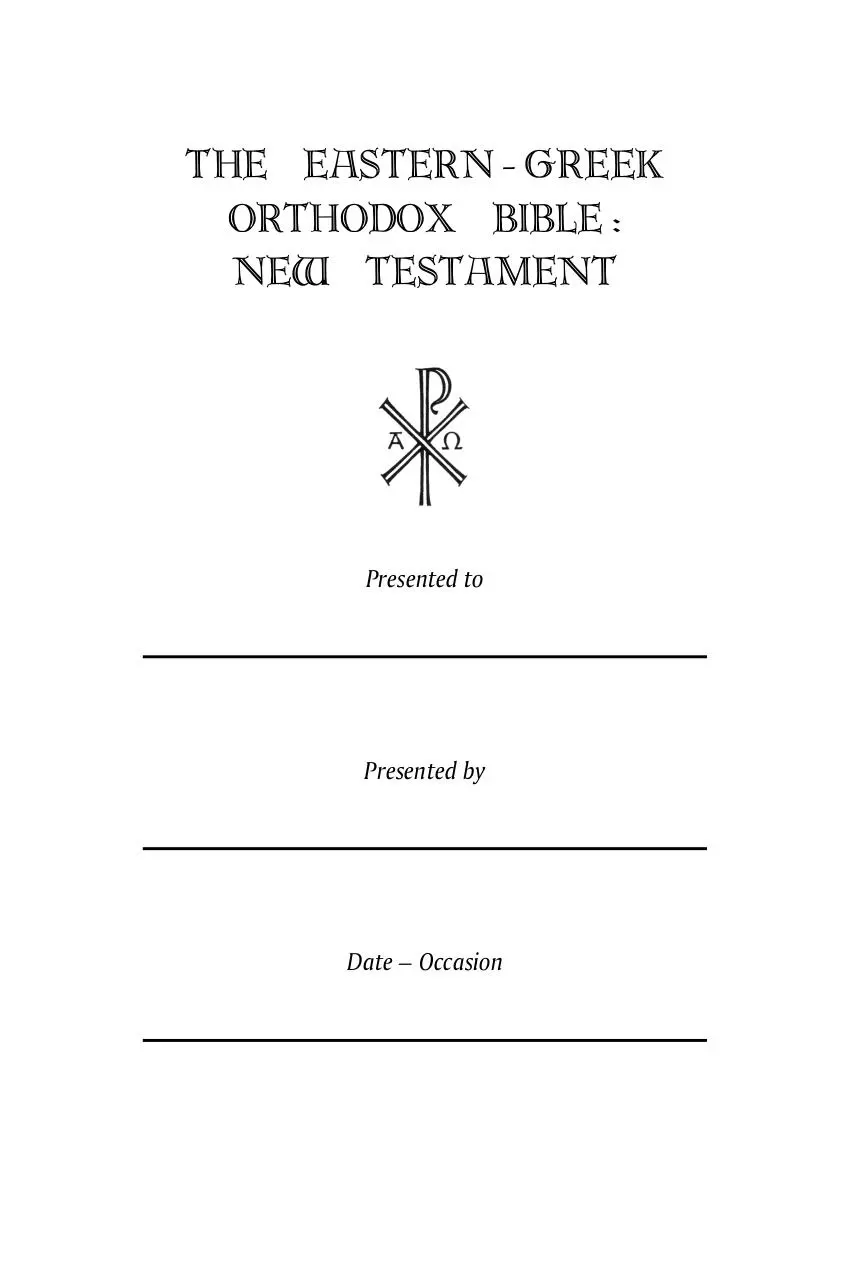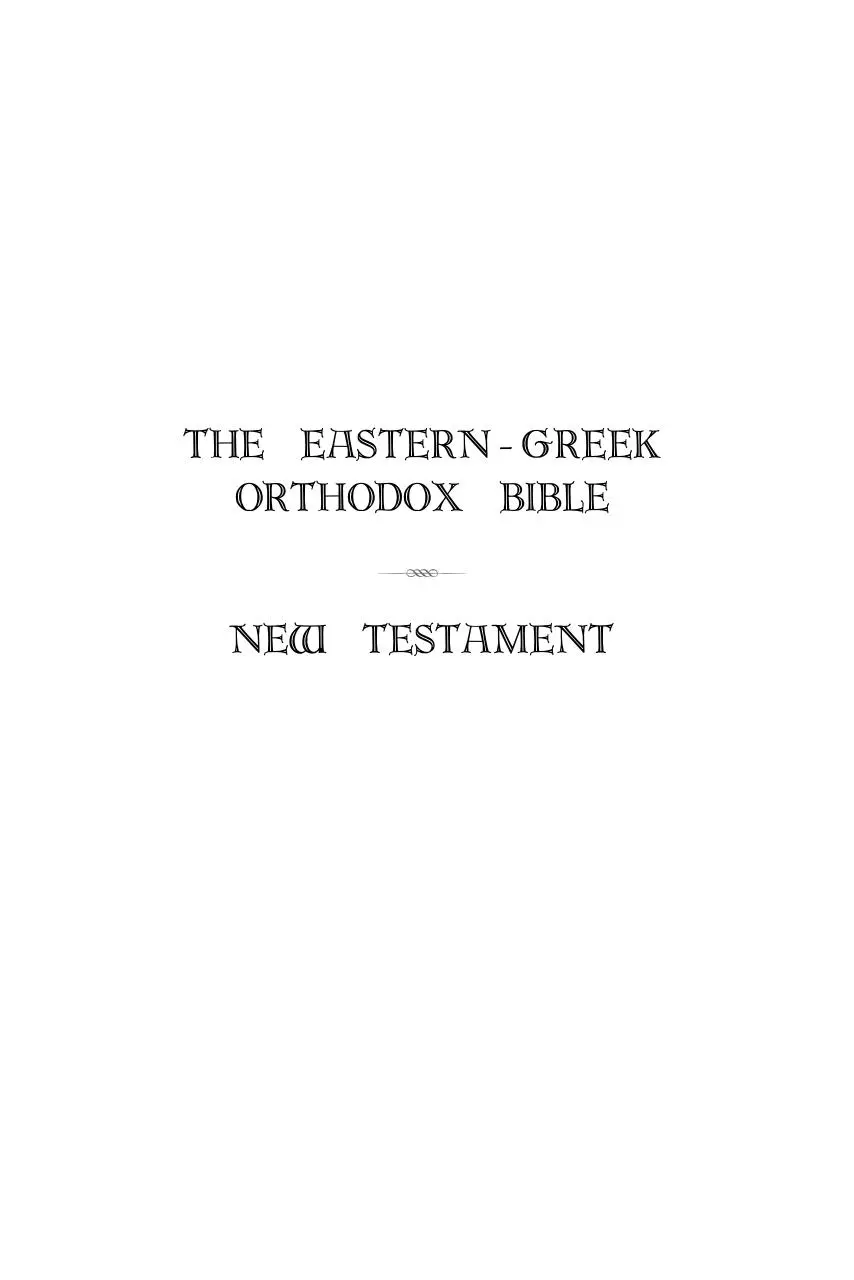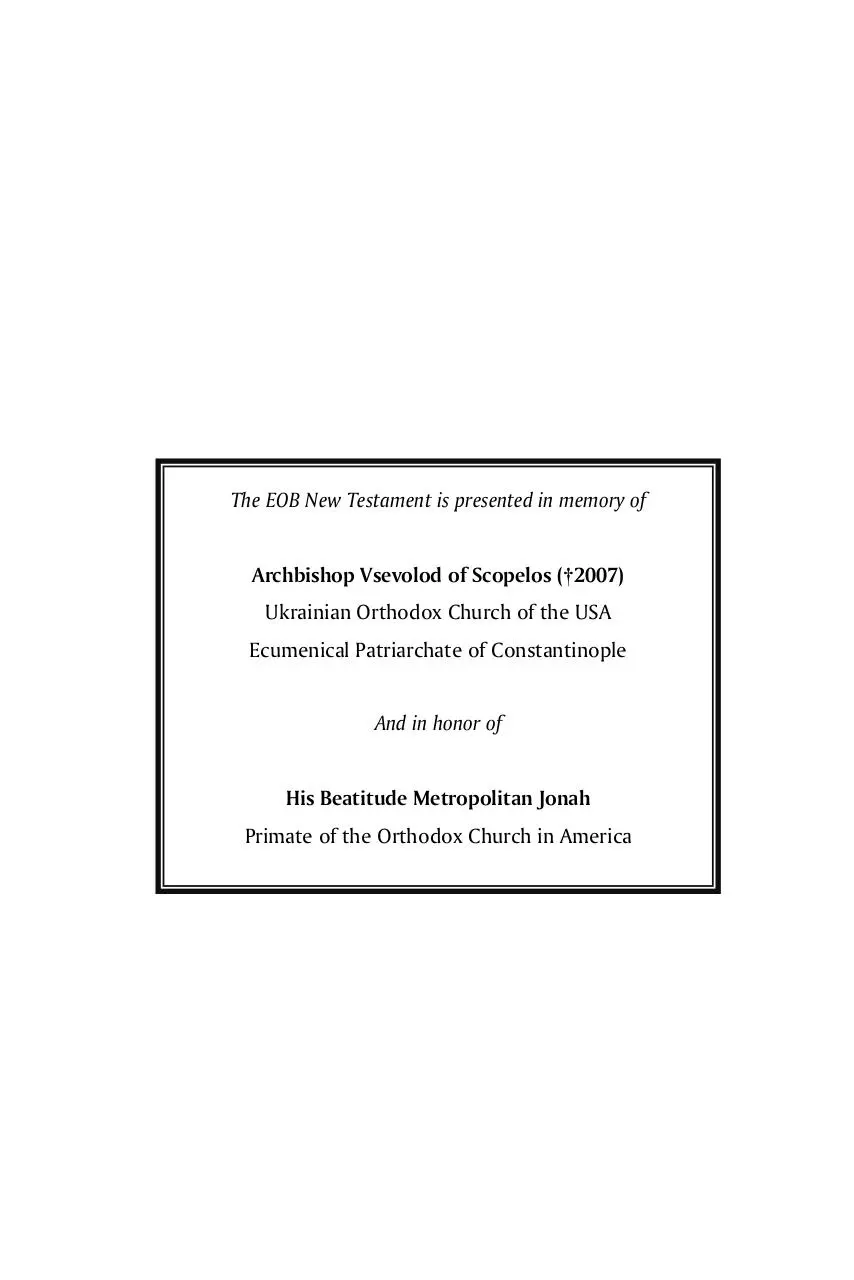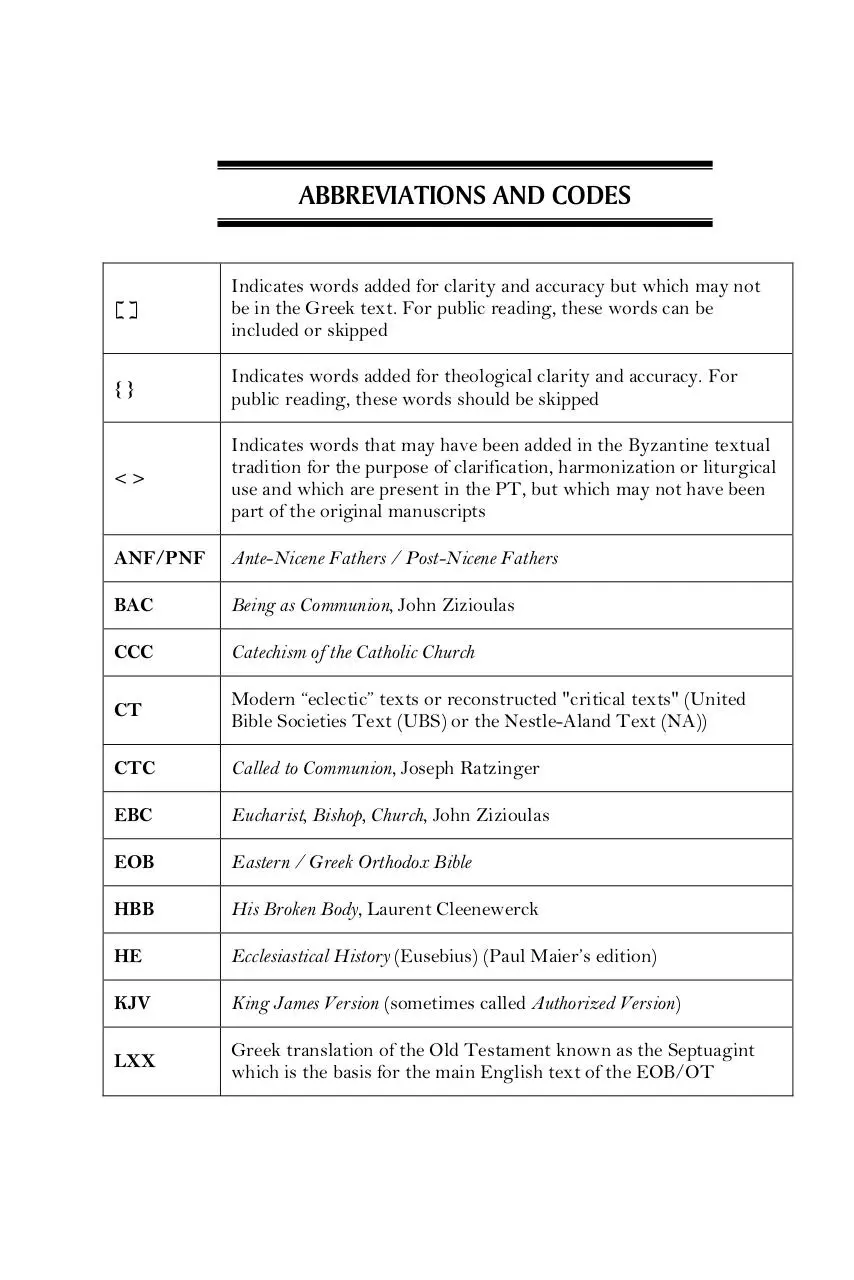THE EASTERN GREEK ORTHODOX BIBLE NEW TESTAMENT (PDF)
File information
This PDF 1.6 document has been generated by PScript5.dll Version 5.2.2 / Acrobat Distiller 9.4.5 (Windows), and has been sent on pdf-archive.com on 18/04/2016 at 04:25, from IP address 71.202.x.x.
The current document download page has been viewed 14128 times.
File size: 6.44 MB (346 pages).
Privacy: public file





File preview
THE EASTERN - GREEK
ORTHODOX BIBLE :
NEW TESTAMENT
Presented to
Presented by
Date – Occasion
THE EASTERN - GREEK
ORTHODOX BIBLE
NEW
TESTAMENT
THE EASTERN / GREEK
ORTHODOX BIBLE
BASED ON THE SEPTUAGINT
AND THE PATRIARCHAL TEXT
NEW TESTAMENT
ALSO KNOWN AS
THE CHRISTIAN GREEK
SCRIPTURES
With extensive introductory and supplemental material
The EOB New Testament is presented in memory of
Archbishop Vsevolod of Scopelos (†2007)
Ukrainian Orthodox Church of the USA
Ecumenical Patriarchate of Constantinople
And in honor of
His Beatitude Metropolitan Jonah
Primate of the Orthodox Church in America
ABBREVIATIONS AND CODES
[]
Indicates words added for clarity and accuracy but which may not
be in the Greek text. For public reading, these words can be
included or skipped
{}
Indicates words added for theological clarity and accuracy. For
public reading, these words should be skipped
<>
Indicates words that may have been added in the Byzantine textual
tradition for the purpose of clarification, harmonization or liturgical
use and which are present in the PT, but which may not have been
part of the original manuscripts
ANF/PNF
Ante-Nicene Fathers / Post-Nicene Fathers
BAC
Being as Communion, John Zizioulas
CCC
Catechism of the Catholic Church
CT
Modern “eclectic” texts or reconstructed "critical texts" (United
Bible Societies Text (UBS) or the Nestle-Aland Text (NA))
CTC
Called to Communion, Joseph Ratzinger
EBC
Eucharist, Bishop, Church, John Zizioulas
EOB
Eastern / Greek Orthodox Bible
HBB
His Broken Body, Laurent Cleenewerck
HE
Ecclesiastical History (Eusebius) (Paul Maier’s edition)
KJV
King James Version (sometimes called Authorized Version)
LXX
Greek translation of the Old Testament known as the Septuagint
which is the basis for the main English text of the EOB/OT
TABLE OF CONTENTS
INTRODUCTORY SECTION
ABBREVIATIONS AND CODES ............................................................................... 9
TABLE OF CONTENTS............................................................................................. 11
THE GREEK ALPHABET ......................................................................................... 13
MANUSCRIPT CODES .............................................................................................. 14
ABOUT THE EOB NEW TESTAMENT .............................................................. 15
THE GOSPELS
INTRODUCTION TO THE SYNOPTIC GOSPELS AND ACTS ................. 35
(ACCORDING TO) MATTHEW (ΚΑΤΑ ΜΑΤΘΑΙΟΝ) .................................. 41
(ACCORDING TO) MARK (ΚΑΤΑ ΜΑΡΚΟΝ) ............................................... 107
(ACCORDING TO) LUKE (ΚΑΤΑ ΛΟΥΚΑΝ) ................................................ 149
INTRODUCTION TO THE GOSPEL OF JOHN ............................................. 219
(ACCORDING TO) JOHN (ΚΑΤΑ ΙΩΑΝΝΗΝ) ............................................... 229
ACTS, EPISTLES AND REVELATION
ACTS OF THE APOSTLES (ΠΡΑΞΕΙΣ ΤΩΝ ΑΠΟΣΤΟΛΩΝ) .................... 281
INTRODUCTION TO THE PAULINE EPISTLES ......................................... 341
ROMANS (ΠΡΟΣ ΡΩΜΑΙΟΥΣ) ............................................................................ 349
1 CORINTHIANS (ΠΡΟΣ ΚΟΡΙΝΘΙΟΥΣ Α)..................................................... 374
2 CORINTHIANS (ΠΡΟΣ ΚΟΡΙΝΘΙΟΥΣ Β) ..................................................... 396
GALATIANS (ΠΡΟΣ ΓΑΛΑΤΑΣ) ........................................................................ 410
EPHESIANS (ΠΡΟΣ ΕΦΕΣΙΟΥΣ) ........................................................................ 418
PHILIPPIANS (ΠΡΟΣ ΦΙΛΙΠΠΗΣΙΟΥΣ) .......................................................... 426
COLOSSIANS (ΠΡΟΣ ΚΟΛOΣΣΑΕΙΣ)................................................................ 432
1 THESSALONIANS (ΠΡΟΣ ΘΕΣΣΑΛΟΝΙΚΕΙΣ Α) ...................................... 438
INTRODUCTION
THE GREEK ALPHABET
Letter Name
Lower Case
Upper Case
Transliteration
Alpha
a
Beta
b
Gamma
g
Delta
d
Epsilon
e
Zeta
z
Êta
e (ê or ē)
Thêta
th
Iota
i
Kappa
k
Lambda
l
Mu
m
Nu
n
Xi
ks
Omicron
o
Pi
p
Rho
r
Sigma
s
Tau
t
Upsilon
u (sometimes v or y)
Phi
ph
Chi
ch
Psi
ps
Omega
ô or ō
INTRODUCTION
ABOUT THE EOB NEW TESTAMENT
PURPOSE
The EOB New Testament was prepared for personal study and liturgical
use in English-speaking Orthodox Christian communities. Its format and
font are designed to make both activities accessible and rewarding. Every
attempt has been made to offer an accurate and scholarly translation of the
Greek text, free of the theological bias that has affected most other
translations of the New Testament, including the NIV (2 Thess. 2:15) and
NAB (Matt. 5:32).
Another intention of this translation is to foster interest in learning the
Greek language (biblical, patristic and modern), which is why many
footnotes make reference to the underlying Greek vocabulary.
The purpose of this edition is also to make the reader aware of possible
textual variants by footnoting all significant instances where the
Patriarchal Text (PT) may not agree with the Textus Receptus (TR), the
Majority Text (MT) or the Critical Text (CT). In several instances, the
footnotes will provide references to specific manuscripts.
Until the publication of the EOB, the King James and New King James
versions have been the preferred translations, partly because they are based
on the Textus Receptus (TR) which is a Byzantine-type text that is close
to the normative ecclesiastical text of the Greek-speaking Orthodox
Churches.
The Textus Receptus (Latin: “received text”) is the name
subsequently given to the succession of printed Greek texts of the
New Testament which constituted the translation base for Luther’s
original German Bible. The TR was also used for the translation of
the New Testament into English by William Tyndale, for the King
James Version, and for most other Reformation-era New
Testament translations throughout Western and Central Europe.
INTRODUCTION
certain issues of translation and terminology (discussed below) also called
for revisions within an Orthodox context.
The EOB (Eastern/Greek Orthodox Bible or Holy Bible of the
[Eastern/Greek] Orthodox Churches) addresses these limitations, both
in the Old and New Testaments. A limited copyright (see inner front page)
is held by the publisher but the text is non-commercial, held within the
Orthodox community and managed as a collaborative project, both for
revisions and for liturgical use. Moreover, Orthodox Christians are invited
to submit their suggestions so that the published text may be regularly
updated and improved.
EOB FOOTNOTES
Unlike the Orthodox Study Bible (OSB), the EOB footnotes focus on
textual and translation issues, and refrain from providing extensive
theological or doctrinal interpretations. Hence, the goal of the main text is
to provide the reader with a clear sense of what the Scriptures say with
possible nuances, not how they should be interpreted.
There are two reasons for this philosophy. The first one is that footnote
commentaries are often perceived as “authoritative” by the reader – almost
on the level of Scripture or official commentary. Hence, the reader’s attention
is directed to particular explanation, at the risk of not letting the inspired
text speak for itself. The second reason is that a few of the explanatory
footnotes of the OSB may be debated among Orthodox theologians, as in the
case of Acts 1:20 and Revelation 17:1 among others. Please refer to the
introductions and appendices for appropriate explanations.
PRIMARY GREEK TEXT(S)
The translation of the New Testament included in the EOB is based on the
official Greek text published by the Ecumenical Patriarchate of
Constantinople in 1904 (Patriarchal Text or PT). During the Turkish
occupation of the Greek lands, various editions of the NT had been
published with significant variants. In 1902, in order to ensure
ecclesiastical harmony, the Ecumenical Patriarchate appointed a committee
whose task was to publish a common and official text. This committee
studied about 20 major Byzantine manuscripts from which they adopted
one as starting point, yet taking into consideration significant variants
from other manuscripts. This text, which is very close to the so-called
Majority Text (MT), was published for the first time in 1904. It has since
then been adopted by all Greek-speaking Orthodox Churches
(Constantinople, Alexandria, Jerusalem, Greece, Cyprus, and Crete). Its
purpose is not to offer an always speculative reconstruction of the original
Download THE EASTERN - GREEK ORTHODOX BIBLE NEW TESTAMENT
THE EASTERN - GREEK ORTHODOX BIBLE NEW TESTAMENT.pdf (PDF, 6.44 MB)
Download PDF
Share this file on social networks
Link to this page
Permanent link
Use the permanent link to the download page to share your document on Facebook, Twitter, LinkedIn, or directly with a contact by e-Mail, Messenger, Whatsapp, Line..
Short link
Use the short link to share your document on Twitter or by text message (SMS)
HTML Code
Copy the following HTML code to share your document on a Website or Blog
QR Code to this page

This file has been shared publicly by a user of PDF Archive.
Document ID: 0000361176.